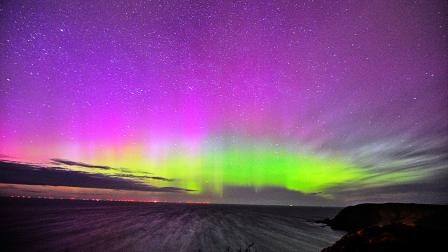Stargazers across the UK were left speechless this week as the Northern Lights Aurora Borealis forecast delivered one of the most mesmerizing displays in recent memory. From the peaceful coastline of Cornwall to the quiet cliffs of Devon, the sky erupted in a vibrant dance of purples and greens. The aurora shimmered above the sea, a rare sight this far south—and one captured beautifully in photos now going viral.
Northern Lights Sparkle Over Devon and Cornwall
This past weekend, unusually strong solar activity led to breathtaking displays of the aurora borealis across parts of southern England. Normally reserved for Scotland or the Arctic Circle, this week’s Northern Lights Aurora Borealis forecast surprised even seasoned astronomers. The Met Office had already issued a notice, hinting at high geomagnetic activity—and they were right.
Locals and tourists alike shared jaw-dropping photos and videos, especially from coastal spots like Bude, Padstow, and Plymouth. The mix of clear skies and minimal light pollution made these areas ideal for aurora watching.
When and Where to Watch the Next Northern Lights Show
If you’re wondering whether more magic is on the horizon, here’s what you need to know:
Upcoming Forecast Highlights:
- Best Viewing Times: Between 10 PM and 2 AM
- Regions to Watch: Northern Scotland, Northern Ireland, and northern England
- Solar Activity: A moderate geomagnetic storm is expected later this week
- Visibility Conditions: Best during cloudless, moonless nights
To catch the lights, head away from city centers. Choose a high point with a wide, dark sky view. Keep an eye on aurora apps or the Met Office space weather page for live updates.
Understanding the Northern Lights Aurora Borealis Forecast
So what makes this rare light show possible? The Northern Lights Aurora Borealis forecast is based on the Sun’s behavior. Powerful solar flares release charged particles, which collide with Earth’s magnetic field. When these particles interact with gases in our atmosphere—oxygen and nitrogen—they create the glowing ribbons we see as aurorae.
Here’s a quick breakdown:
| Cause | Effect Seen on Earth |
|---|---|
| Solar Flare | Surge in charged particles |
| Geomagnetic Storm | Disruption in Earth’s magnetic field |
| Atmospheric Reaction | Glowing colors in the sky (green, pink, violet) |
These predictions aren’t always precise, but when a G2 or G3 storm is expected, aurora activity spikes—and that’s when you’ll want your camera ready.
Why This Week’s Aurora Was So Special
According to experts, this week’s aurora was the result of a particularly fast-moving Coronal Mass Ejection (CME) that hit Earth. This intensified the aurora’s reach, lighting up skies that haven’t seen it in years.
For residents of the South West, it was a once-in-a-lifetime moment. The mix of sea reflections, cliffs, and lights created a surreal natural performance that some photographers say rivaled Iceland’s displays.
Staying Updated with the Northern Lights Aurora Borealis Forecast
If you’re hoping to catch the next event, follow these tips:
- Use Real-Time Aurora Forecast Tools – Apps like My Aurora Forecast, AuroraWatch UK, and the NOAA website give live KP index updates.
- Check Local Weather – A cloudless sky is essential.
- Look North – The aurora typically starts low on the northern horizon.
- Stay Warm and Patient – The show often comes in waves.
Let’s Wrap Up
This week’s sky spectacle reminded us that nature still holds the power to surprise. Whether you’re in the far north or lucky enough to glimpse the aurora further south, keep your eyes on the sky. The Northern Lights Aurora Borealis forecast continues to promise unexpected moments of wonder. Don’t miss them.
